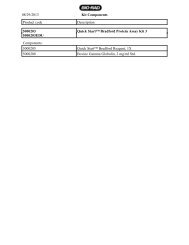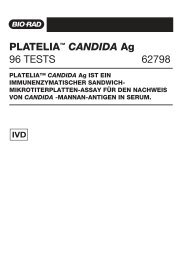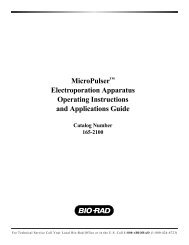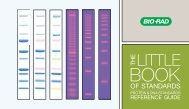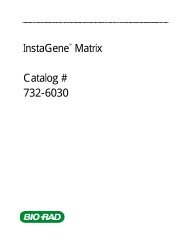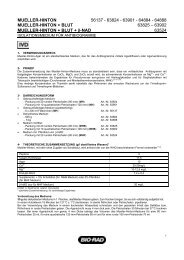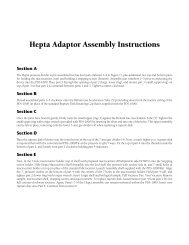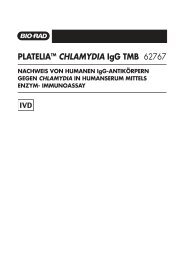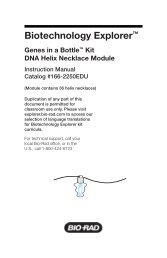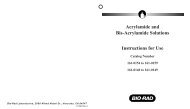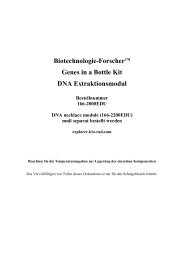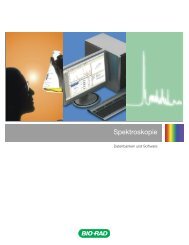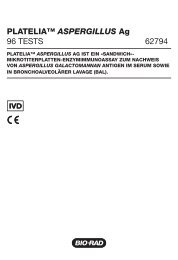Protein Expression and Purification Series - Bio-Rad
Protein Expression and Purification Series - Bio-Rad
Protein Expression and Purification Series - Bio-Rad
Create successful ePaper yourself
Turn your PDF publications into a flip-book with our unique Google optimized e-Paper software.
<strong>Protein</strong> <strong>Expression</strong> <strong>and</strong> <strong>Purification</strong> <strong>Series</strong><br />
Tasks to Perform Prior to the Lab<br />
Note: Several reagents are used in different parts of the advance preparation as well as for different<br />
laboratory activities. Do not discard excess reagents used in preparation <strong>and</strong> store them at the<br />
appropriate conditions.<br />
Streaking starter plates to produce single bacterial colonies on agar plates<br />
1. Preparation of ampicillin: With a sterile pipet, add 600 µl of sterile water to each vial containing<br />
30 mg ampicillin to rehydrate the antibiotic, making a 50 mg/ml (500x) solution.<br />
Note: Ampicillin is used to make LB/amp agar plates as well as LB/amp broth, so do not discard any<br />
unused ampicillin solution. The rehydrated ampicillin should be stored at –20°C <strong>and</strong> is good for one<br />
year.<br />
2. Preparation of LB/amp agar plates: At least two days prior to cell culturing, prepare one LB/amp<br />
agar plate per team to be used to inoculate E. coli starter cultures.<br />
Note: Only prepare 200 ml of molten LB agar reagent (enough for 20 plates) to which 200 µl of 50<br />
mg/ml ampicillin will be added to make LB/amp agar plates. Retain excess 50 mg/ml ampicillin at<br />
–20°C for use in preparation of LB/amp broth.<br />
This protocol is used to prepare solid LB/amp agar media to prepare plates for the growth of starter<br />
colonies of BL21(DE3) E. coli containing the pDHFR plasmid. Each student group will require one LB/amp<br />
agar plate. Agar plates should be prepared at least two days before required, left out at room temperature<br />
for two days <strong>and</strong> then refrigerated until they are to be used. Two days on the bench allows the agar to dry<br />
out <strong>and</strong> more readily take up the rehydrated E. coli solution.<br />
Figure 3B.1. Preparation of LB/amp agar.<br />
A. To prepare 20 LB/amp plates, prepare 200 ml of LB agar. Add 8 g of LB nutrient agar to 200 ml<br />
of distilled water in a 500 ml or larger Erlenmeyer flask <strong>and</strong> cover the flask opening. Swirl the flask<br />
to dissolve the agar, or add a magnetic stir bar to the flask <strong>and</strong> stir on a stir plate. A stir bar will also<br />
aid in mixing the solution once sterilization is complete. Autoclave the LB agar on the wet cycle for<br />
30 minutes. Once the autoclave cycle is complete, check the solution to ensure that the agar is<br />
completely dissolved.<br />
Note: Be sure to wear appropriate protective equipment <strong>and</strong> be careful to allow the flask to cool<br />
slightly before swirling process so that the hot medium does not boil over onto your h<strong>and</strong>.<br />
If no autoclave is available, heat the agar solution to boiling in a microwave or on a hot plate. Repeat<br />
the heating <strong>and</strong> swirling about three times until all the agar is dissolved (no more clear specks are<br />
noticeable). Use a lower power setting on the microwave to reduce evaporation <strong>and</strong> boilover.<br />
Chapter 3B: Advance Preparation for<br />
Chromatography Instrumentation Protocols<br />
73<br />
CHAPTER 3B<br />
ADVANCE PREP<br />
INSTRUMENTATION PROCES



